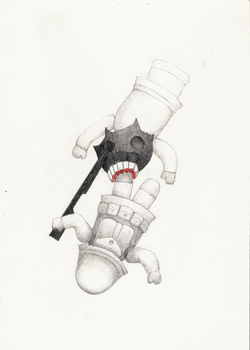Crawling, marching, climbing
Baustelle Schaustelle Gallery, Essen, Germany / 2010
Photo: Stefanie Pluta
Crawling, marching, climbing.
Solo exhibition, Baustelle Schaustelle gallery, Germany
09.3.2010-10.1.2010
Rimma Arslanov introduces a political aspect to Baustelle Schaustelle with her installation which was designed specifically for this venue. The artist, who lives in Israel, created an exciting dialogue between drawings and between objects made of sugar which she managed to arrange perfectly in the Schaustelle’s small showroom. Viewers observing this scene are both taken aback and perplexed. The protagonists of her installations and drawings are soldiers made of sugar who have been reduced to comic figures. In her drawings they are also portrayed as two opposing parties fighting an apparently unsolvable battle at gun point. The figures resemble toys or cartoon characters. Their physiognomy is reminiscent of the installations by the Chapman brothers. Initially, they seem like toys fooling around or playing “Gotcha”, a popular recreational sport among young people, in which two “rivalling” teams have to hit each other with paintballs. This impression is reinforced by the little soldier who is isolated on a sideboard among miniature Gotcha paintballs and is begging for mercy. However, closer scrutiny reveals that the ammunition cannot be completely harmless. The “impacts” in the wall behind the figure prove that loaded weapons are being used in this “game”. For this reason, the sugar comrades in this installation, which takes up the centre of the room, seem to be trying to seek shelter; they crawl through the sand made of sugar, search for exits and salvation, and yet some of them drown in the “quick-sugar”. Finally, the tunnel system shown on a further drawing links the deadly political events in the Middle East with the former situation here. This work refers to Essen and the company Krupp’s role as gunsmiths during the First and Second World War when miners were still being sent underground while a war was raging up above.
Text: Vanessa Sondermann.
Rimma Arslanov has taken a completely different approach. She developed her design on the basis of the past war-related events in the region. These events are close to her heart as she lives in conflict-ridden Israel. Although her visual language is clear and minimalist, it also contains decorative elements. Her colour scheme is reduced to varyingly intense shades of graphite, white and red highlights.
Her large drawings show battle scenes, there are active, wounded, torn apart and dead figures, but also figures that seem to be lost within the setting itself. On the one hand, each figure seems to be fighting alone against the others and on the other hand, they all seem to belong together. The figures in her pictures are doll-like, schematic, phalloid soldiers without identities. Friends and foes cannot be distinguished from one another, they all resemble each other with regard to shape and colour. Only a few figures are distinguished by grotesque, dark masks instead of helmets. Their demeanour is particularly aggressive. The artist chose red to highlight their bullets.
Arslanov’s small drawings are of an equally explosive nature. Although decoratively and aesthetically executed, the brutality of the subject once more becomes apparent upon closer examination of these studies of various cartridges, and of wounded or dead soldiers.
The materials the artist chose for her sculptural display add another regional aspect: she cast her figures of soldiers in sugar, water and gelatine. She picked sugar as a contrast to the different shades of coal and iron. All three materials have in common that they are the result of manufacturing processes. However, sugar conveys an impression of fragility and brittleness which emphasises the horrors of combat and thereby, the fine line between life and death. In this context, Rimma Arslanov reduces the colours even more and sets the scene in monochrome shades of white. The soldiers appear even more like dolls in this sculptural rendition. However, in spite of its colourfulness, this setting does not seem innocent. The figures on the table seem to want to escape from the situation: they run, crawl and climb. Their status is precarious. Some of these figures are headless, have no limbs or are on fire. They are surrounded by pearly beads with an ambivalent significance. On the one hand, they allude to the bullets in the drawings and on the other hand, these beads lie like lost souls among the figures.
The scene’s brutality culminates in the site-specific wall installation which the artist developed at the showroom itself: a lonely sugar soldier has been placed at eye-level on a small board in front of the wall. He is exposed and vulnerable, and holds his arms in front of his helmet in an attempt to protect himself. The holes and red beads in the wall behind him are evidence of massive bombardment. Viewers find themselves in an unpleasant position: do their glances have the same effect as the shooting? This dilemma inspires an even greater concern with the topic than the ornamental approach in the drawings.
At most, the young generation of today associates the events of the war with the stories belonging to their grandparents’ generation. Rimma Arslanov has revived this topic. Thanks to her choice of materials and the means of implementation, she manages to convey the horror and pointlessness of war in a powerful and emotional way: doll-like, playfully arranged figures interrupt harsh reality with the aid of their fragile materiality and demonstrate the bodily harm suffered by these experiences.
The art award exhibition series ends with Rimma Arslanov’s show. Starting from different perspectives, each of the three prize-winning artists presented a powerful approach and focussed on the aspect of coal and steel production in the Ruhr Area without resorting to clichés.
Text: Sandra Kuhlmann.
 |
|---|
 |
 |
 |
 |
 |
 |
 |
 |
 |
 |
 |
 |